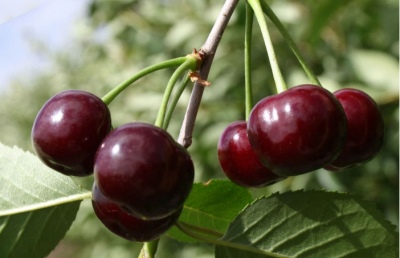
- Barrel type: bush
- Growth type: undersized
- Crown: compact
- Flowers: pinkish white
- Fruit color: from ruby to maroon
- Fruit weight, g: 3,5-4
- Taste: sweet, with noticeable sourness
- Appointment: universal
- Flowering period: starts in late April or early May, lasts 2-3 weeks
- Early maturity: 3 years after planting
The size of the territory of the garden or dacha does not always allow planting large trees. In this case, you should pay attention to dwarf varieties. Among them, the Winter pomegranate cherry is gaining more and more popularity.
Breeding history
This variety was born relatively recently. It was bred as a result of the efforts of scientists and foreign farmers. Working with seedlings, they crossed steppe ("Canadian") cherries with sandy ones.
Description of the variety
The tree is characterized by low growth and modest height - 1.5-1.8 m. The crown is compact, the trunk is divided into a small number of branches with neat shoots.
Fruit characteristics
Cherries of the described variety have a weight of 3.5-4 grams. The thick peel prevents them from spoiling in hot weather, allows them to be safely transported, stored and frozen. Cherries range in color from ruby to deep burgundy. The bone is diminutive.
Taste qualities
The fruits of this variety stand out among their fellows with a particularly harmonious taste - sweet, with a well-felt sourness. Their composition includes only 14 percent sugar. The fruit has a universal purpose. Jam, marmalade, and marshmallow will turn out to be equally tasty.
Ripening and fruiting
Dwarf cherry blossoms can be seen in May, when they are covered with delicate pinkish-white flowers. The Winter pomegranate sings in the second or third decade of July. The first fruits from the tree can be removed in the third year from the moment of planting, but a bountiful harvest will have to wait 6-7 years.

Yield
The variety in question gives a decent harvest - up to 10 kilograms per bush.
Growing regions
On the territory of our country, this dwarf cherry can be successfully grown in many areas, starting from the Moscow region and ending with Vladivostok, but with the condition that the summer temperature there will not be below 10 degrees. The best climate for this variety is sharply continental.
Self-fertility and the need for pollinators
The Winter pomegranate variety belongs to self-fertile plants. This means that cherries do not need pollinating trees. About 25-40% of the ovaries are formed on it even without the mediation of bees.
Landing
For planting, it is advised to select young two- or three-year-old cherries with a powerful root system. There should be several branches on a straight trunk. It is advisable to prepare the soil loose, with good oxygen permeability. Chernozem does not need chemical fertilizers, and they will not interfere with sandy loam or loamy soil.
You can dig holes for planting in the fall, freeing up space from weeds in advance. The parameters of the hole can be 60x60x60 cm. In the spring, planting young plants in the ground is only worth in the second half of April, when there will be no snow and the ground warms up well.
Cherry Winter pomegranate should be planted on the southern side of the garden: where there is a lot of light and the shadow of any structures will not fall on it. And away from conifers. On the eve of planting, part of the soil from the planting hole is mixed with wood ash and superphosphate and the bottom is covered with this combination.
The seedling is scrupulously inspected for dry or rotten areas, pests. If necessary, the cherries are sprayed with insecticide. To improve root growth, the plant is left in a bucket of water for a day. The seedlings are immersed in the planting hole, without covering the root collar with earth to the end. After that, the Winter Pomegranate must be well watered.


Growing and care
After completing planting, the tree should be pruned, watered, fed with fertilizers and loosened around it in time. The first watering is carried out in the spring, at a soil temperature of 5-10 degrees, then it all depends on the weather.
In the first year of the tree's life, fertilization is not required, since this was done when planting. When the cherry blossoms, nitrogen should be added to the soil. In the summer - organic. In autumn - phosphorus, calcium and potassium. The first pruning of the Winter pomegranate is done immediately after planting, removing the twigs growing half a meter from the ground. In the spring, they get rid of dead shoots.


Disease and pest resistance
The Winter pomegranate variety has excellent resistance to many diseases and pests. However, one should not forget about preventive procedures.
It is recommended to carry out a number of simple activities:
- spray "Karbofos" from aphids, "Aktara" from attacks of weevils and fungicides from moniliosis;
- whitewash the trunk in the spring;
- in the fall, remove fallen leaves and dig up the soil.
Requirements for soil and climatic conditions
The described variety was created for areas with severe winters. Agricultural technicians declare that it can tolerate up to 40-45 degrees of frost with honor. In addition, the roots of the Winter Pomegranate cherry are deep in the ground, so the tree can feed on groundwater and easily tolerate drought.

Review overview
Despite the fact that the variety is young, there are already a lot of reviews about it, and in general they are positive. Gardeners note the balanced flavor of the berries, a decent harvest and praise the ability to withstand harsh climatic conditions.































































